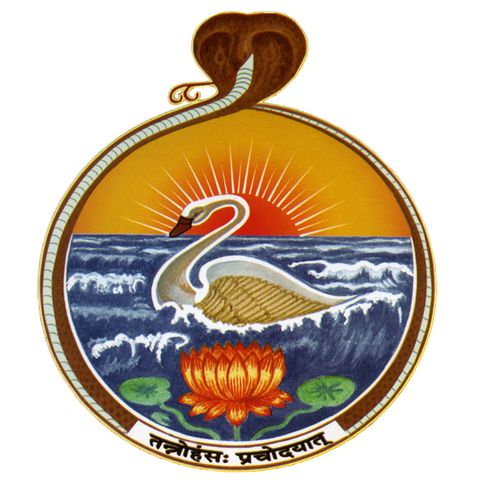88 - Daivi Sampat And Asuri Sampat | Swami Tattwamayananda

Download and listen anywhere
Download your favorite episodes and enjoy them, wherever you are! Sign up or log in now to access offline listening.
Description
-9th chapter: verses 8, 9, 10, 11, 12, 13 -The lecture was given by Swami Tattwamayananda on June 25, 2021. -8th verse: “Animating My own prakriti, I project this whole...
show more-The lecture was given by Swami Tattwamayananda on June 25, 2021.
-8th verse: “Animating My own prakriti, I project this whole multitude of different beings. Then they exist, but they are helpless and not free.”
-So long as we are attached to prakriti, under the influence of the three gunas, we are in a state of helplessness and we are not free – we are slaves in the hands of our own samskaras. We are helpless against old age, sickness and death.
-We spend most of our lifetime confronting the problem of death – we may be able to postpone it, but we cannot avoid it. Yaksha posed a question to Yudhishthira – “What is the most mysterious fact of life?” In answer, Yudhishthira said – “Every minute and second, we see so many creatures moving towards the abode of death. Still, we believe that we will not have to join this procession. This is the most mysterious fact of life.”
-When a person asks the question - “what is the nature of death?” – that is the beginning of his higher spiritual evolution. Nachiketa’s story and his three boons from Kathopanishad is a good illustration of this spiritual evolution. The three boons that Nachiketa asks are: (1) Let my father not scold me when I return (2) Teach me rituals to get to heaven and (3) Teach me the reality beyond death. Yama then describes life as a journey for highest spiritual enlightenment.
-9th and 10th verses: “I am the one behind this cycle of creation. Presided over by Me, Prakriti brings forth moving and unmoving things. I am there in everything, but I am not part of it. I am the immanent, inherent, divine principle present in everything, and that regulates everything. But I remain uninvolved, unattached.”
-Brahman does not have a purpose and remains unaffected. Prakriti produces moving and unmoving things as manifestation from the causal form. Dissolution is effect going back to its causal form.
-An iceberg is not a creation – rather, it is just a projection of water. Similarly, in Vedanta, the world is not a creation – rather, it is a projection, and not separate from its causal form.
-11th verse: “People who are not aware of my higher nature, they consider me as a human being. They do not recognize Me in my spiritual dimension as the divine principle in everything.”
-This idea of God creating the visible world is illustrated through a magician performing the “Indian Rope Trick “in Shankaracharya’s commentary on the Mandukya Karika. When the magician performs his magic, only the magician is real. The magic is delusion. Similarly, God is the magician and real. The whole creation is like magic, which is only relatively real.
-In a semi-dark room, we may mistake a rope to be a snake and try to run away. When we bring light, what we formerly misunderstood to be a snake is now recognized as a rope. As a snake, it is unreal. As rope, it is real.
-A jivan-mukta realizes the relative nature of the phenomenal world. At the same time, he becomes more humane, showing friendliness, generosity and compassion towards everyone. He does so without being bound.
-12th verse: “Certain people, who do unnecessary, useless things out of vain knowledge, ignorance, haughtiness – they are possessed of the quality of evil-doers (asuri-sampat).
-13th verse: “The great souled ones, they are possessed of the divine nature (daivi-sampat). They know Me as the origin and as immutable. They worship Me with a dedicated mind.”
-Verses 1, 2 and 3 of 16th chapter provide 26 characteristics of people endowed with divine wealth (daivi-sampat). Examples of such characteristics are fearlessness, purity, interest in scriptures and practice of non-violence. Those who possess these virtues have entered the path of manifesting their inner divinity.
-Shankaracharya describes the characteristics of a sattvic person. Such a person reads and gets knowledge of higher virtues from scriptures, which are recorded diaries of the path traveled by realized teachers. He then internalizes these teachings and practices them in his life.”
-Such a sattvic person is bold, speaks the truth, is forgiving, practices purity, and has no hatred or pride.
-Strong will is necessary for spiritual practice to help us raise ourselves and to face obstacles from the external world and from our own mind.
-True strength comes when it is devoid of pride and is enriched by a sense of renunciation and non-attachment. Lord Krishna says in the 11th verse of the 7th chapter of the Gita: “Of the strong, I am their strength that is devoid of desire and attachment.”
-Saints and mystics, such as Swami Vivekananda, demonstrated strong will to raise themselves in their spiritual life. They were very humble, but behind their humility was great Atma-balam – the inner strength of Atman. The strength of a great person who uses it for the good of others - that transcendental touch is an expression of the divine.
-In the concluding verse of each Gita class, we say: “Hari Om Tat Sat. Sri Ramakrishna Arpanam Astu”. It means we offer everything to Vishnu and Sri Ramakrishna. Om is the auspicious word symbol of the essence of the Vedas.
Information
| Author | Vedanta Society, San Francisco |
| Organization | Vedanta Society, San Francisco |
| Website | - |
| Tags |
Copyright 2024 - Spreaker Inc. an iHeartMedia Company

Comments